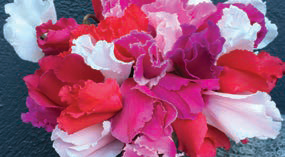


Renowned independent florist, Ruth Monaghan shares her thoughts and techniques on how to get the most from the humble but top performing Cyclamen
Autumn is my favorite time of year. From the depths of hues of flames of oranges and ochres to the plunge of purple to the bounties of berries and textured leaves, I feel spoilt for choice.
An almost forgotten florist’s flower amongst the Samhain harvest is the curious form of the Cyclamen, but one which I feel needs to raise its head above the parapet and be heralded
for both its form and function for flower creations. These beauties are so dainty, so delicate and come in shades from white through to red, magenta and purple and a wealth of colours in between. Some, but not all are scented. No wonder I feel spoiled.
Cyclamen season falls between October and February and as cut flowers, their stems have a vase life of approximately a week. Despite their amazing aesthetic qualities, what I adore most about cyclamen is their heritage. The name Cyclamen comes from the Greek word ‘kyklos’ meaning ring or circle, the ‘amen’ comes from Hebrew meaning truly in reference to the coiled fruiting stalk and rounded tubers. The species name hederifolium derives from the Latin for ivy or Hedera and folium meaning leaf. Another common name is sowbread, the corms are regarded as a favourite food for swine in the south of France, Sicily and Italy but its prettiness in its punkiness is far better than a term like that.
Cyclamen hederifolium is native to woodland, shrubland, and rocky areas in the Mediterranean region from southern France to western Turkey and on Mediterranean islands, and naturalised farther north in Europe and in the Pacific Northwest. It is the most
widespread cyclamen species, the most widely cultivated after the florist’s cyclamen (Cyclamen persicum), and the hardiest and most vigorous in oceanic climates. It is classified in the family Primulaceae.
The symbolism of the cyclamen lies in resignation and goodbye. Other beliefs around the cyclamen include that if its flower is worn by a woman in labour, her childbirth would be easier. It is reputed to protect against nightmares if placed beside your pillow and to make a recipient fall in love with the sender. It’s also meant to raise one’s self-esteem and confidence. Whichever association you prefer, they all sound pretty positive and magical.
Cyclamen is a delightful perennial that sports colour when all else is grey and wintered. Ideal for shady borders and banks, this relative of the primrose is the perfect autumn gift. It literally springs to life once the first of the autumn rains fall lasts for weeks and keeps a succession of flowers during the season of short daytimes. As long as it is kept watered without a frost, it will follow the common pattern of coming into growth in the autumn, growing through the winter and spring and then going dormant while there is no rain and intense sun in the summer.
But then for us florists, the best thing this season is that we can buy cut Cyclamen
to add that extra sense of magic to our work.
Conditioning is key to having the cut cyclamen stem survive for a few weeks. We usually receive them in dry batches so the first thing we do is to slice the stems vertically with a pin or very fine sharp knife. We then place the stems in a centimeter of water and store in a fridge. With a 20cm stem length, the cut Cyclamen suits our famous Tray of Blooms and also the malleable stem can be wrapped around the inside of a vase, bound into small bouquets and fixed into jar posies. Their colour and scent add that extra twist of texture and uniqueness for the time of year. Our favourite so far this year is the red magenta version.
So let’s herald this autumn bloom which will also bring great winter delight, to plant in a bed or a pot, or arrangement. ✽
 Ruth Monahan is one of the most Ireland’s most successful independent florists. She is managing director of Appassionata Flowers, a thriving Dublin-based florist with a retail shop on Drury Street and a floral studio on South Cumberland Street. She can be contacted via email at ruth@appassionata.ie and via her website at www.appassionata.ie Ruth Monahan is one of the most Ireland’s most successful independent florists. She is managing director of Appassionata Flowers, a thriving Dublin-based florist with a retail shop on Drury Street and a floral studio on South Cumberland Street. She can be contacted via email at ruth@appassionata.ie and via her website at www.appassionata.ie |





